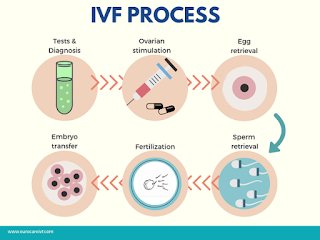Understanding the Process of Test-Tube Baby
In vitro fertilisation or IVF is a kind of assisted reproductive technology (ART) that helps women get pregnant who cannot conceive naturally due to some certain conditions.
Louise Joy Brown was the first-ever baby to
be born through the IVF procedure in 1978 and then, the non-medical term used
for it was ‘test tube baby.’ By
the mid of 2018, over 8 million test tube babies have been born with this
technique.
Natural conception vs. In vitro fertilisation
For a woman to get pregnant naturally, the
fertilisation has to occur inside the body and it happens when the male
partner’s sperm penetrates the egg of the woman. The fertilised egg then
attaches itself to the lining of the uterus and starts developing into a baby.
Talking about in vitro fertilisation, the
fertilisation occurs outside the body in a laboratory dish under the
environmentally controlled chamber. Once the egg is fertilised, it turns into
an embryo which is then implanted into the uterus.
Process of test tube baby
Ever since the first
test tube baby born, the IVF process has seen several
advancements. However, the core process always remains the same.
Suppression of natural menstrual cycle
In the very first step of the IVF
procedure, the fertility specialist doctor gives drugs through injections daily
for two weeks to suppress the natural menstrual cycle of the woman.
Controlled ovarian hyperstimulation
Also known as superovulation, in this step,
the doctor gives the woman drugs containing follicle-stimulating hormone (FSH)
that cause ovaries to produce more eggs than normal. With the help of
ultrasound scans, the doctor keeps an eye on the process of ovaries.
Retrieval of eggs from ovaries
The doctor performs follicular aspiration, a
minor surgical procedure for the retrieval of eggs from ovaries. Before
beginning this procedure, they give mild sedatives or anaesthetic to the woman
so that she does feel any pain or discomfort. In this procedure, a needle is
inserted into the ovary through the vagina which is connected through a suction
device to help with the ejection of eggs.
Conception and fertilisation
In this step, retrieved eggs are kept under
observation in an environmentally controlled chamber. When fertilisation successfully
happens, it undergoes the process of embryo culture. The process usually takes
two to three days.
Embryo transfer
In the final step of the IVF process, the
doctor, on the approval of the couple, selects one or more embryos for the
implantation. With the help of a very thin tube or catheter, they transfer the embryo(s)
which attaches itself to the lining of the uterus and then starts developing
into a baby.
So, this is how a test tube baby is born. However, choosing the right fertility
clinic also plays a crucial role in the success of an IVF treatment.



Comments
Post a Comment